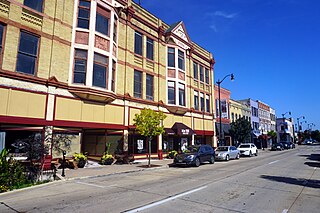
Janesville is a city in and the county seat of Rock County, Wisconsin, United States. As of the 2020 census, the city had a population of 65,615, making it the tenth-most populous city in Wisconsin. It is a principal municipality of the Janesville–Beloit metropolitan statistical area, which consists of all of Rock County and is included in the greater Madison–Janesville–Beloit combined statistical area.

The Wisconsin Conservatory of Music is an independent music school in Milwaukee, Wisconsin. It teaches classical, jazz, rock, folk, and blues and hosts musical concerts throughout the year. It is housed in a Neoclassical-style mansion built in 1904 for Charles L. McIntosh, treasurer of J.I. Case. In 2000 the building was listed on the National Register of Historic Places.

The Lincoln–Tallman House is a historic Italianate-style house in Janesville, Wisconsin. Built and constructed in 1857 by the Tallman family, the house once hosted overnight guest Abraham Lincoln before he became U.S. President.

Ferry & Clas was an architectural firm in Wisconsin. It designed many buildings that are listed on the National Register of Historic Places. George Bowman Ferry and Alfred Charles Clas were partners.

James O. Douglas was an American architect in Wisconsin. He has been called a "noted Milwaukee society architect".

The Mansion Hill Historic District encompasses a part of the Mansion Hill neighborhood northwest of the capitol square in Madison, Wisconsin. In the 19th century the district was home to much of Madison's upper class, and held the largest concentration of large, ornate residences in the city, but in the 20th century it shifted to student housing. In 1997 the district was added to the National Register of Historic Places.

The East Brady Street Historic District is located in Milwaukee, Wisconsin. It was added to the National Register of Historic Places in 1990.

The Historic Sixth Street Business District is a set of largely intact two and three-story shops along the main road coming into Racine, Wisconsin from the west. Most of the buildings were constructed from the 1850s to the 1950s. The district was added to the National Register of Historic Places in 1988.

The Southside Historic District is a large, prestigious historic neighborhood in Racine, Wisconsin, including over 500 contributing structures in various architectural styles. It was added to the National Register of Historic Places in 1977.

The Courthouse Hill Historic District is a 30-block area on the east side of Janesville, Wisconsin, containing many historic structures built from the mid-1800s to the early 1900s in various styles, including homes of many of Janesville's influential leaders from that period. The district was added to the National Register of Historic Places in 1986.

Allen Perry Lovejoy was a Wisconsin politician, lumber merchant and manufacturer from Janesville, Wisconsin.

The Near East Side Historic District is a neighborhood in Beloit, Wisconsin composed of stylish homes of prominent citizens from the 1800s and the buildings of Beloit College. It was added to the National Register of Historic Places in 1983.

The Maple Park Historic District is a historic neighborhood that lies northwest of the downtown of Lake Geneva, Wisconsin, United States. Part of the original city plat for Lake Geneva, it was first home to early settlers before the town became known as a retreat for wealthy Chicagoans. The district was added to the National Register of Historic Places in 2005.
Hiram Merrill was an American businessman and Wisconsin pioneer. He was the 18th mayor of Janesville, Wisconsin, and a member of the Wisconsin State Assembly.

The Northwest Side Historic District is residential district in central Stoughton, Wisconsin, United States with 251 contributing homes built from 1854 to 1930. In 1998, the neighborhood was listed on the National Register of Historic Places.

The South Main Street Historic District is a surviving collection of eleven commercial buildings built from 1877 to 1915 in the old downtown of Oregon, Wisconsin, plus the WWI memorial. It was added to the State and the National Register of Historic Places in 2000.

The South Main Street Historic District a fairly intact remnant of Janesville, Wisconsin's old downtown east of the Rock River, built in the 19th and early 20th centuries. In 1990 the district was added to the National Register of Historic Places.

The Old World Third Street Historic District is the last relatively intact part of the original German retail district in Kilbourntown plat in Milwaukee, Wisconsin, United States. It contains examples of various styles of Victorian commercial architecture going back to 1855. It was listed on the National Register of Historic Places in 1987 and on the State Register of Historic Places in 1989.

The Old Fourth Ward Historic District in Janesville, Wisconsin is a large old working-class neighborhood southwest of the downtown, comprising about 1100 contributing structures built from the 1840s to 1930. In 1990 the district was listed on the National Register of Historic Places.






















